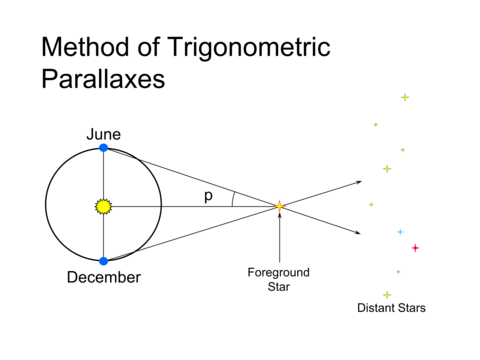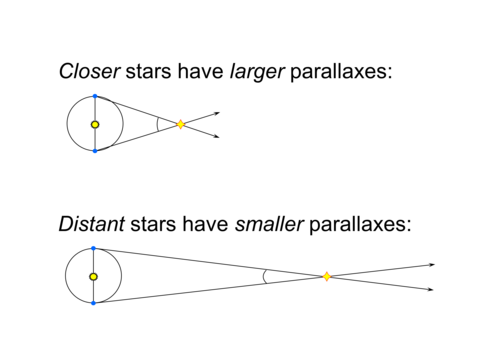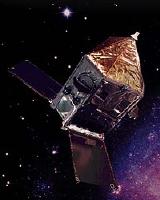
Introduction to Stars, Galaxies, & the Universe
Prof. Richard Pogge, MTWThF 9:30

|
Astronomy 162: Introduction to Stars, Galaxies, & the Universe Prof. Richard Pogge, MTWThF 9:30 |
Examples of such problems:
Answer:

(Click on the image to view at full scale [Size: 177Kb])
In the picture above, the line of sight to the star in December is different than that in June, when the Earth is on the other side of its orbit. As seen from the Earth, the nearby star appears to sweep through the angle shown. Half of this angle, is the parallax, p.

(Click on the image to view at full scale [Size: 165Kb])
In the upper figure, the star is about 2.5 times nearer than the star in the lower figure, and has a parallax angle which is 2.5 times larger.
This movie demonstrates parallaxes graphically (beware: it is big, don't try to download it over a slow network connection).
This gives us a means to measure distances directly by measuring the parallaxes of nearby stars.
We call this powerful direct distance technique the Method of Trigonometric Parallaxes.
For example, the nearest star, Proxima Centauri, has a parallax of 0.772-arcsec (the largest parallax observed for any star).
First parallax observed 1837 (Friedrich Bessel) for the star 61 Cygni.
We use photography and digital imaging techniques to measure parallaxes today. Increasingly, we measure parallaxes from space to avoid blurring due to the Earth's atmosphere.

Writing our parallax formula in this way allows us to define a new "natural" unit for distances in astronomy: the Parallax-Second or Parsec.
1 parsec (pc) is equivalent to:
1 light year (ly) is equivalent to:
The light year is used primarily by writers of popular science books and science fiction writers. It is rarely used in research astronomy.
The reason is that the parsec is directly derived from the quantity that is being measured (the stellar parallax angle), whereas the light-year must be derived from having previously measured the distance in parsecs. In this way, the parsec is a more "natural" unit to use than the light year.


In general, the greater the distance, the smaller the parallax, and so the less precise the distance measurement will be.
The smallest parallax measurable from the ground is about 0.01-arcsec. This means that from the ground, the method of Trigonometric Parallaxes has the following limitations.

The Hipparcos satellite (launched by the European Space Agency in 1989) measured precision parallaxes to an accuracy of about 0.001-arcsec.
Hipparcos represented a great leap in our knowledge of the distances (and motions) of nearby stars. The catalog was just released in late 1997, and is already having an impact on many areas of astronomy that rely in accurate distances.
For more information about the Hipparcos mission, visit the Hipparcos Mission Website at ESA.
Gaia is a European follow-up mission to Hipparcos that was launched on 19 December 2013, reaching its orbital station at the Earth/Sun L2 point in January 2014, and began science operations in July 2014. Its goal is to conduct what amounts to a Galactic census. Gaia is undertaking an all-sky survey of the Galaxy that build up high-precision angular measurements through repeated measurements. The final Gaia data catalog will not be completed until about 2020.
Mission Goals: